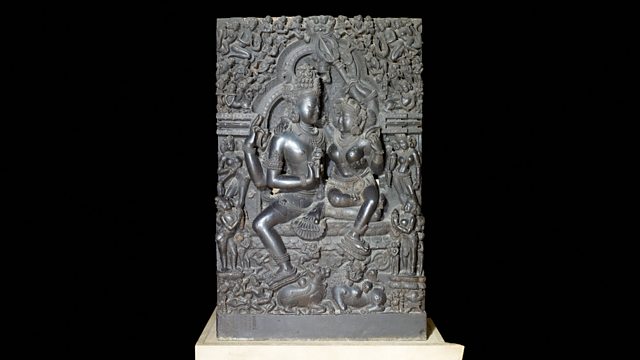Shiva and Parvati sculpture
Neil MacGregor is with the gods - exploring religious art during the 14th and 15th centuries. Today he is with a sculpture of the Hindu deity Shiva and his consort Parvati.
The history of humanity as told through one hundred objects from the British Museum in London is back in India. This week Neil MacGregor is with the gods - exploring the sophistication of religious art in the 14th and 15th centuries, as people around the world sought ways of finding physical expression for devotion and for representing the divine.
Today Neil is with a magnificent stone sculpture showing the powerful deity Shiva with his consort Parvati seated on his knee - two of the most beloved and familiar figures of Hinduism. The vehicles of the deities, a bull and a lion, and their children sit at their feet, while a host of supporting musicians and attendants swirl around their heads. Neil considers how images like this help cement the relationship between deity and devotee.
The writer Karen Armstrong considers the special relationship between male and female aspects in spiritual practice while the Hindu cleric Shaunaka Rishi Das explores the particular characteristics of Shiva and Parvati and considers the religious significance of their union.
Producer: Anthony Denselow
Last on
![]()
Discover more programmes from A History of the World in 100 Objects about religion
About this object
Location: Orissa, India
Culture: Ancient South Asia
Period: 13th century AD
Material: Stone
��
This statue of the divine Hindu couple, the great god Shiva and his wife Parvati, would have probably been placed above a door to a temple. Hindu worshippers used sculptures to develop a close relationship with the gods depicted. Gods would only inhabit a perfectly made statue and sculptors had to ritually purify themselves before they commenced carving. Such statues were primarily for beginners. Experienced worshippers were expected to commune with the gods through prayer and meditation without images.
What do Shiva and Parvati symbolise?
This statue comes from Orissa on the East coast of India. The arrival of Islam in North India in the 1200s caused the centre of Hinduism to shift to south and central India. Orissa was associated with the god Shiva and tantric Hinduism focussed on esoteric teaching and hidden rituals. Shiva represents contrasting values ?both lust and purity, peace and destruction. When depicted together with his wife, Parvati, he represents the union of male and female and marital fidelity.
Did you know?
- In myth Parvati was daughter of the mountain, child of Himavan, lord of the mountains and personification of the Himalayas.
The same person in different forms
By Shaunaka Das, Hindu cleric and director of the Oxford Centre for Hindu Studies
��
I can tell one little story. Shiva and Parvati were sitting on mount Kailash where Shiva lives and he was giving a class – a lecture – to a number of sages who had come to take his darshan. And Parvati was sitting on his lap.
Now these sages were all ascetics – all celibate – and Shiva himself was sitting there, a very detached person, with his wife sitting on his lap – a very attractive wife. And this maharaja Chitraketu was passing by and he saw this scene and he thought it was very funny that all these ascetics and Shiva were sitting together having a class on spiritual life and detachment with this beautiful woman sitting on his lap with his arm around her. And he laughed. And no one took it seriously except Parvati. And Parvati thought this was offensive to her husband so she cursed Chitraketu that he would have to take life as a demon.
So there’s this little kind of vignette of the character of Shiva and Parvati. Shiva very detached, never takes offence, and Parvati takes all his offences on his behalf it seems.
Shiva-Parvati, Lakshmi-Narayan are in one sense the same person manifest in two different forms. So God is male and female. And the thinking behind that is that God cannot be something less than we are. So God cannot be not-female, because there are females here, so God has to have a female aspect.
Transcript
Broadcasts
- Wed 7 Jul 2010 09:45����ý Radio 4 FM
- Wed 7 Jul 2010 19:45����ý Radio 4
- Thu 8 Jul 2010 00:30����ý Radio 4
- Wed 14 Jul 2021 13:45����ý Radio 4
Featured in...
![]()
Religion—A History of the World in 100 Objects
A History of the World in 100 Objects - objects related to religion.
Podcast
-
![]()
A History of the World in 100 Objects
Director of the British Museum, Neil MacGregor, retells humanity's history through objects





